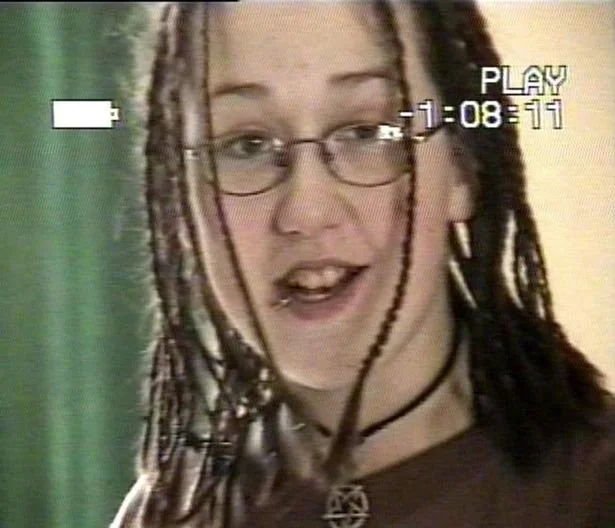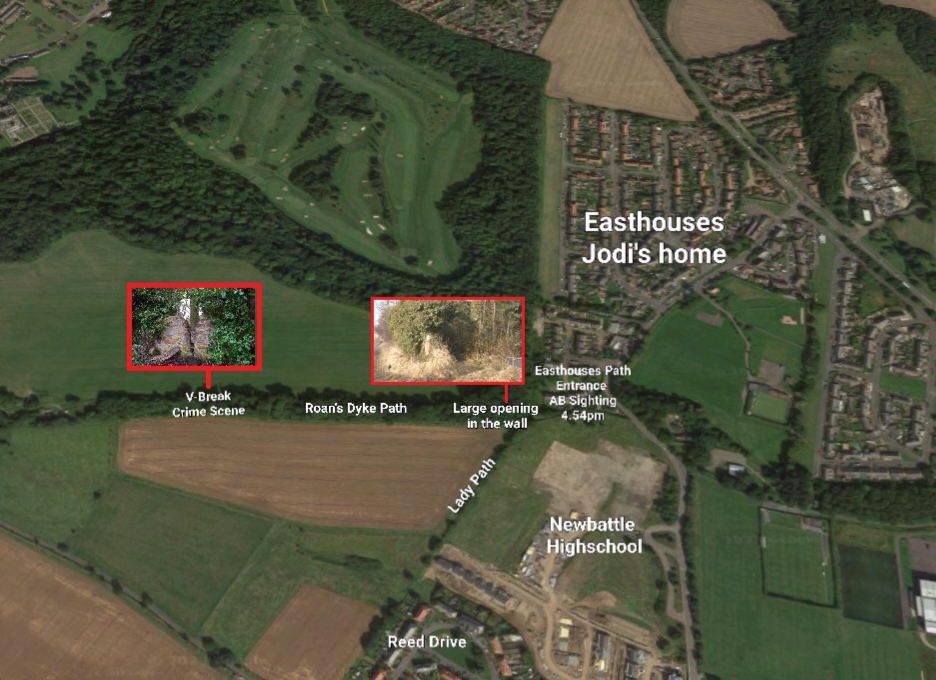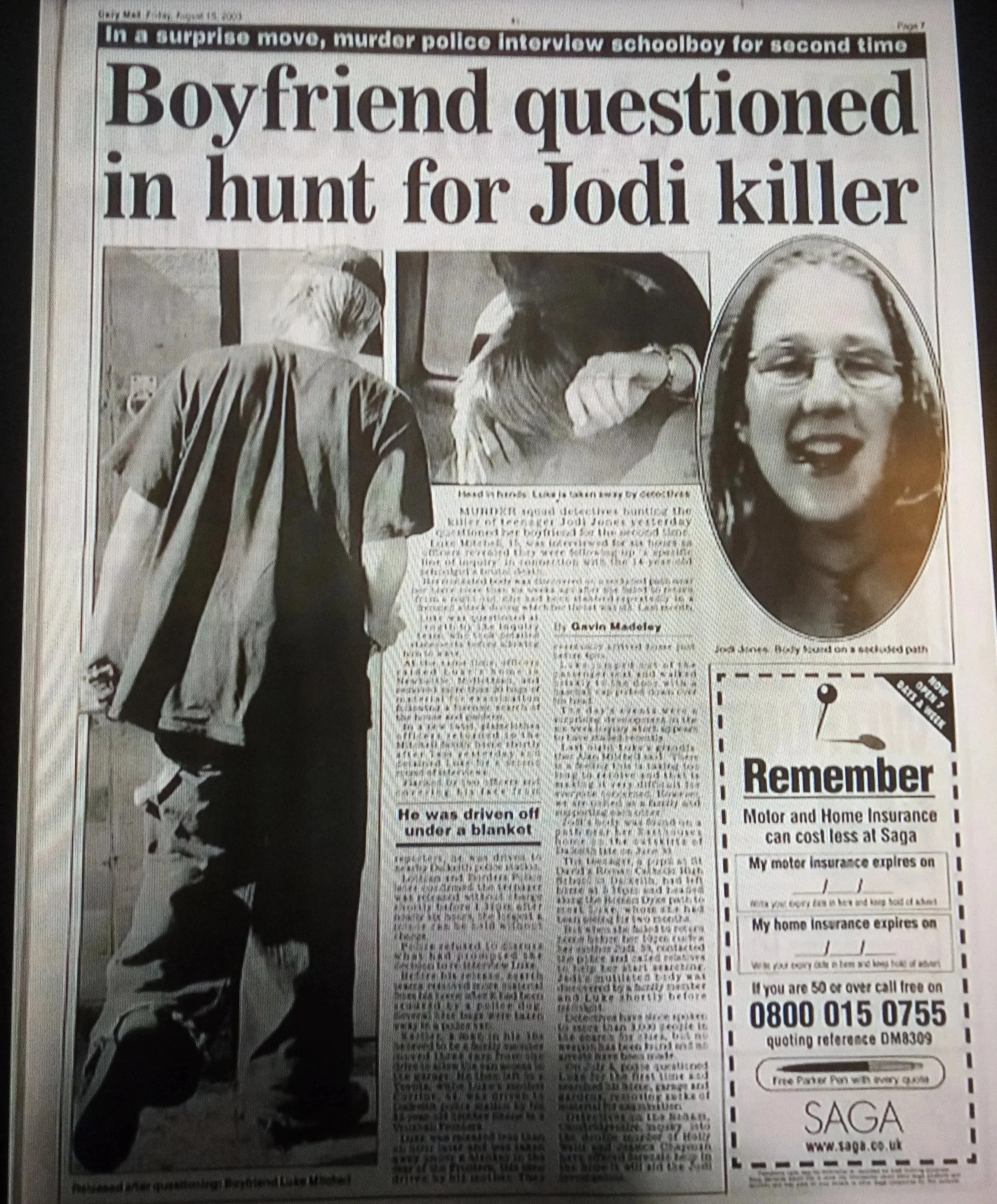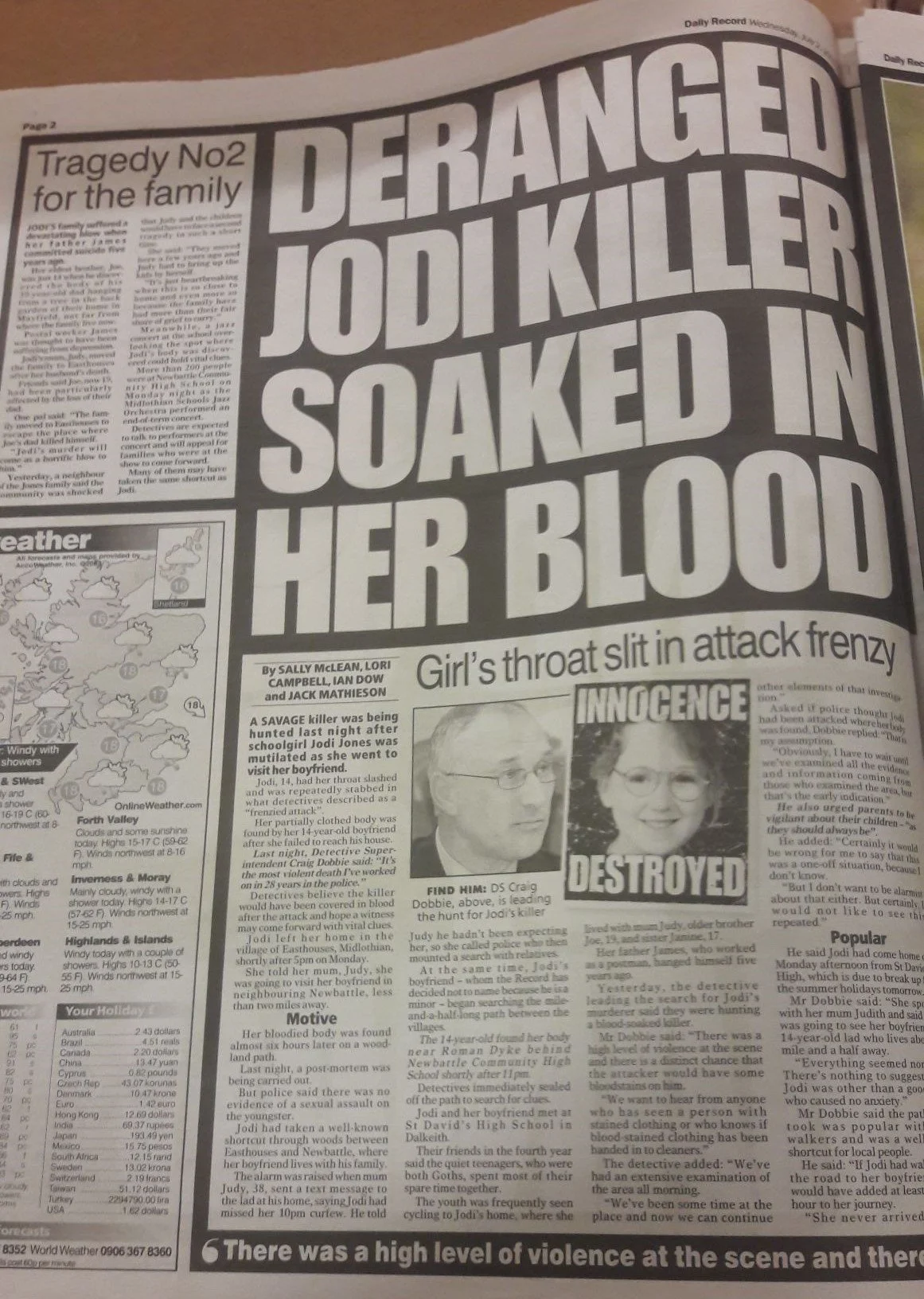Case Summary
Jodi Jones was a 14-year-old girl whose life was brutally taken in June 2003. Her tragic death shocked Scotland, yet the investigation that followed, and the conviction of her boyfriend Luke Mitchell, have left enduring questions about whether true justice was ever served.
Jodi Jones
The Murder of Jodi Jones
On 30 June 2003, 14-year-old Jodi Jones left her home in Dalkeith during the early evening. When she did not return, concern grew, and her family, together with her boyfriend Luke Mitchell and his dog Mia, began searching the nearby woodland. Later that night, Jodi’s body was discovered hidden behind a break in the wall along a path close to her home known as Roan’s Dyke Path. Her death shocked her community and marked the beginning of one of Scotland’s most controversial murder investigations.
Map showing Roan’s Dyke Path
A Desperate Struggle
Evidence at trial showed that Jodi Jones put up a desperate fight against her attacker. She sustained defensive wounds to her arms as she tried to protect herself while being repeatedly stabbed. Her injuries were extensive and brutal, including wounds to her head, neck, torso, and arms, consistent with a violent and sustained assault. Jodi’s body was found semi-naked, with her trousers being used to bind her hands together behind her back. Her throat had been cut multiple times and with such force that it was described in court as close to decapitation.
A Mishandled Crime Scene
Jodi’s body was improperly secured at the scene and left uncovered and exposed for around eight hours, which risked destroying critical evidence. At trial, forensic experts described the scene as “not ideally managed,” highlighting how branches were cut, and the body relocated before proper investigation began. The crime scene was not well contained: bin collections and hedge trimming continued, while children walked past the scene to make their way to the nearby Newbattle High School, potentially contaminating or wiping away clues.
Untested and Ignored DNA Evidence
Forensic teams spent 18 months examining hundreds of items from the crime scene, Jodi’s clothing, and Luke Mitchell’s belongings. The trial heard that no DNA, fingerprints, or forensic traces were ever recovered that directly linked Luke to Jodi’s murder.
The only trace cited by the prosecution was a small amount of Jodi’s DNA on a pair of Luke’s trousers. But those were not the trousers he wore on the night of the murder. They were recovered later from a holdall used the previous weekend when Luke had stayed at his father’s. Experts agreed this trace could be explained by innocent transfer, given the pair’s relationship.
Other findings highlighted unanswered questions:
122 items tested for DNA and fingerprints yielded no link to Luke.
Jodi’s bra showed DNA from more than two individuals, including male material that has never been linked to any individual.
DNA from Steven Kelly, Jodi’s sister’s fiancé, was found on the t-shirt Jodi was wearing.
A condom recovered near Jodi’s body carried semen that did not match Luke Mitchell. The owner of the profile was only identified years later, when their DNA was put through the database in connection with an unrelated offence.
Despite this extensive forensic work, no murder weapon was recovered, no forensic link to Luke, and multiple profiles pointing to other individuals, the investigation and prosecution remained fixed solely on him. Crucial forensic leads that might have pointed elsewhere were not pursued.
The Circumstantial Case Against Luke
With no direct forensic evidence and no murder weapon recovered, the Crown’s case against Luke Mitchell was built entirely on circumstantial evidence. At trial, prosecutors set out three “pillars” that they argued supported guilt.
1. Alleged Guilty Knowledge
The prosecution argued that Luke demonstrated “guilty knowledge” when Jodi’s body was discovered. Members of the search party later claimed that Luke had led them straight to the break in the wall where Jodi lay.
In the first weeks after the murder, however, their statements were consistent with Luke’s own account — that he initially passed the wall, his dog Mia began “air sniffing” and jumping at the wall, and he then doubled back and climbed through the gap. Only after a month did statements begin to shift, increasingly suggesting that Luke had guided them directly to the scene.
3. The Alibi and Family Pressure
Luke’s defence was that he was at home cooking dinner at the time of the murder. This was corroborated by phone records up to 16:25, and by his mother and brother until around 17:30, when he left to meet Jodi. Neighbours also reported seeing him acting normally outside his home that evening, wearing the same clothes he had worn at school earlier.
Police, however, did not accept the alibi. Both Luke’s mother and his brother were charged with attempting to pervert the course of justice, though these charges were later dropped. Luke’s brother, Shane, was also subjected to aggressive questioning, similar to what Luke went through. Appeal judges later described Luke’s own interrogation as ‘abhorrent’ — designed more to break him down than to obtain reliable answers.
A Case Built on Inference
These three pillars — guilty knowledge, a disputed sighting, and a compromised alibi — formed the backbone of the Crown’s case. Each rested on inference and shifting testimony, not direct evidence. The defence argued throughout that these strands could not amount to proof beyond a reasonable doubt.
2. Disputed Witness Sighting
A witness known as “AB” testified to seeing a male and a female near the Easthouses end of the path around the time Jodi was believed to have been killed.
The descriptions given did not clearly match Luke or Jodi, and the timing contradicted other sightings from people who knew Jodi. The witness also failed to identify Luke when asked to point him out in court. Nevertheless, the jury accepted this as supporting circumstantial evidence that Luke was with Jodi at the time of her death.
Trial by Media
From the earliest days of the investigation, media coverage framed Luke Mitchell as the prime suspect. For nearly ten months before his arrest, national and local outlets ran frequent stories focusing on his image, interests, and lifestyle. This created an atmosphere where Luke was effectively tried in the press before ever entering a courtroom.
Newspapers seized on Luke’s interest in heavy metal and goth culture, framing these as indicators of a dark or violent character. Police statements fed this narrative, telling reporters that they would be investigating links between Jodi’s murder and the “goth movement” just days after her death.
Luke’s school jotters, covered with references to video games, were presented as sinister. His interest in music by Marilyn Manson was used to suggest an obsession with violent imagery. Investigators even directed officers to search his home for connections to Manson and to the infamous “Black Dahlia” murder.
The Black Dahlia
At trial, prosecutors argued that Luke was inspired by Manson’s paintings of Elizabeth Short, the “Black Dahlia” victim. They suggested Jodi’s injuries mirrored the killing. Yet the pathologist who examined Jodi’s body testified that any similarities were superficial and that the injuries were markedly different.
By the time of Luke’s trial, however, the association had already been widely reported, fuelling the public perception of him as a killer obsessed with death and the occult.
Prejudicial Atmosphere
Media outlets repeatedly described Luke as “evil,” “obsessed with knives,” and “dark.” The sheer volume and tone of coverage made it impossible to separate fact from speculation in the public mind. By the time jurors were empanelled, Luke had been portrayed for months as the only possible suspect, shaping the environment in which the trial was conducted. With no direct forensic link to the crime, the prosecution’s circumstantial pillars gained weight largely because of the media narrative that surrounded them. Luke’s image, his music, his drawings, his lifestyle, was placed on trial alongside him, reinforcing a picture of guilt long before the jury delivered its verdict.
The Impact of Pre-Trial Reporting
The sheer scale and intensity of the media coverage placed a 14-year-old schoolboy under relentless public scrutiny long before he ever stood trial. This level of exposure blurred the line between allegation and fact, shaping public opinion and creating a climate in which impartiality was all but impossible. For a child defendant, the consequences were profound: his image, friendships, and interests were presented as evidence of guilt in the court of public opinion. The case stands as a stark example of how sensationalist reporting can compromise the fairness of justice, particularly when the accused is still a minor.
Naming Luke Mitchell at 15
On 15 April 2004, The Press & Journal ran a front-page story headlined “Boyfriend charged with murdering schoolgirl Jodi”, identifying Luke Mitchell by name. At the time, Luke was just 15 years old — still legally a child — and due to appear in court the following day.
Ordinarily, the Criminal Procedure (Scotland) Act prevents newspapers from identifying anyone under 16 involved in criminal proceedings. Prosecutors argued that the paper had broken this law, since a petition warrant had already been granted for Luke’s arrest. However, in 2007 Aberdeen Journals, publishers of The Press & Journal, were cleared. The court ruled that because Luke had not yet appeared in court when the article was published, the report was not technically “a report of proceedings in court,” and therefore did not breach the Act.
This legal distinction meant that, despite being under 16, Luke could be publicly named and labelled as Jodi’s killer from the outset. While not illegal, it meant that before his trial had even begun, Luke was widely identified as the prime suspect in the press — reinforcing the perception of guilt at an age when the law is normally meant to protect anonymity.
Scottish Daily Mail, 5 July 2003. Used here for educational purposes. Just days after Jodi’s murder, Luke Mitchell was publicly identified as the focus of police suspicion. Coverage like this shaped early public opinion before any charges were brought, portraying Luke as the only suspect and narrowing the investigation’s focus.
Daily Mail (Scottish edition), 15 August 2003. Luke Mitchell’s second police interview was headlined in a way that again foregrounded him as the prime suspect. The imagery and wording reinforced an assumption of guilt months before trial, illustrating the intense pressure of media coverage.
Daily Record, 2 July 2003. Front-page coverage of the Jodi Jones case, used here for education and public discussion. Early headlines used emotive and sensationalist language, presenting the crime in lurid detail alongside an old picture of Jodi taken when she was 8 years old; she was 14 when she was horrifically murdered. Such framing risked reinforcing a presumption of guilt in the public mind and heightened the sense of moral panic around the case.
The Verdict and Aftermath
After Scotland’s longest single-accused trial, lasting 42 days, the jury returned a majority guilty verdict against Luke Mitchell on 21 January 2005. He was sentenced to life imprisonment with a punishment part of 20 years. At just 16 years old, Luke became one of the youngest people in Scotland to receive such a sentence.
The verdict brought closure for some, but deep unease for others. The conviction rested entirely on circumstantial evidence: alleged guilty knowledge, a disputed witness sighting, and a compromised alibi. There was no murder weapon, no DNA, and no direct forensic evidence connecting Luke to Jodi’s death.
The failings in this case go beyond Luke Mitchell’s conviction. Jodi Jones was a 14-year-old girl who deserved the most thorough investigation possible. Instead, the crime scene was mishandled, critical DNA evidence was overlooked, and the inquiry narrowed too quickly onto a single suspect.
By failing to properly test leads and explore alternative explanations, the investigation has left uncertainties that continue to undermine confidence in the verdict.
Nearly two decades on, this case continues to divide opinion. Luke Mitchell has always maintained his innocence, while others remain convinced the jury reached the correct verdict. What cannot be denied is that the investigation and trial were marked by serious shortcomings.
Those failings mean Scotland is left with a conviction but without certainty. Until those unanswered questions are addressed, doubts will remain, and the integrity of the justice system itself is undermined.
Demand Truth, Demand Justice
Jodi Jones was a young girl who deserved the full truth about what happened to her. Instead, her case was marred by a mishandled crime scene, overlooked DNA, and an investigation that fixed too quickly on a single suspect. Luke Mitchell was convicted without a shred of direct forensic evidence, on a case built entirely on circumstantial pillars and media-fuelled prejudice.
Twenty years on, questions still hang over this case. Those questions matter, not only for Luke Mitchell, but for Jodi Jones, and for the integrity of Scotland’s justice system.
Join us in demanding truth, transparency, and accountability. Share this story, challenge the narrative, and help shine a light on a case that remains one of Scotland’s most troubling miscarriages of justice.
Justice for one is justice for all.







